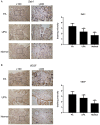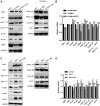The role of Zeb1 in the pathogenesis of morbidly adherent placenta
- PMID: 31322233
- PMCID: PMC6691258
- DOI: 10.3892/mmr.2019.10490
The role of Zeb1 in the pathogenesis of morbidly adherent placenta
Retraction in
-
[Retracted] The role of Zeb1 in the pathogenesis of morbidly adherent placenta.Mol Med Rep. 2025 May;31(5):128. doi: 10.3892/mmr.2025.13493. Epub 2025 Mar 21. Mol Med Rep. 2025. PMID: 40116079 Free PMC article.
Abstract
Zinc finger E‑box‑binding homeobox 1 (Zeb1) is a promoter of epithelial‑mesenchymal transformation, which may serve an important role in morbidly adherent placenta (MAP). In the present study, the protein expression levels of Zeb1 were examined in the placenta tissues of 60 patients, including 20 patients with placenta accreta (PA) and 20 patients with placenta previa without PA (UPA) and 20 patients in late pregnancy that delivered by cesarean section (normal). The expression levels of Zeb1, N‑cadherin, vascular endothelial growth factor (VEGF), Tumor necrosis factor‑related apoptosis‑inducing ligand‑receptor 2 (TRAIL‑R2), and tumor necrosis factor‑related apoptosis‑inducing ligand‑receptor 3 (TRAIL‑R3) were higher in PA tissues compared with in normal control tissues. The expression levels of E‑cadherin and TRAIL‑R2 were decreased in PA tissues compared with in normal control tissues. These findings indicated that Zeb1 may serve an important role in placental attachment, thus promoting the development of dangerous PA. Overexpression of Zeb1 may upregulate the expression levels of N‑cadherin, VEGF, TRAIL‑R3, cyclin D1 and Bcl‑2, and downregulate the expression levels of E‑cadherin and TRAIL‑R2. In addition, Zeb1 regulated the viability, apoptosis and migration of HTR‑8/SV neo cells and human umbilical vein endothelial cells by regulating the Akt pathway. In conclusion, these findings indicated that Zeb1 may promote placental implantation by activating the Akt signaling pathway, thus providing a theoretical basis for investigating the causes of MAP.
Figures






References
-
- Roziana R, Kamarul Azhar K, Lau JH, Aina MAA, Nadia R, Siti Nordiana A, Mohd Zulkifli K. Morbidly adherent placenta: One-year case series in a tertiary hospital. Med J Malaysia. 2019;74:128–132. - PubMed
-
- Lopes ES, Feitosa FEL, Brazil AV, de Castro JDV, da Costa JIF, Araujo Júnior E, Peixoto AB, Carvalho FHC. Assessment of sensitivity and specificity of ultrasound and magnetic resonance imaging in the diagnosis of placenta accreta. Rev Bras Ginecol Obstet. 2019;41:17–23. doi: 10.1055/s-0038-1675803. - DOI - PMC - PubMed
Publication types
MeSH terms
Substances
LinkOut - more resources
Full Text Sources
Research Materials
Miscellaneous

